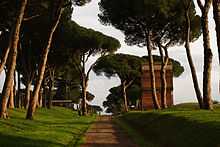Tombs of Via Latina

The Tombs of Via Latina (Italian: Tombe di Via Latina) are Roman tombs, mainly from the 2nd century AD, that are found along a short stretch of the old Roman road of Via Latina, close to Rome, Italy. They now constitute an archaeological park and can be visited.
History
These tombs were discovered in 1857-58 by Lorenzo Fortunati, a teacher who dabbled in archaeology and made money by selling some of the items he found.[1] A series of excavations supported by Pope Pius IX subsequently uncovered various sepulchres and tombs along a short stretch of the road about 6 km southeast of the centre of Rome. The area was subsequently expropriated from the Barberini family by the Italian State in 1879.[2] In 1900, further excavations were initiated under the supervision of Rodolfo Lanciani.
The Archaeological Park
The park extends for a short distance of 450 meters. In addition to the tombs, part of the original basalt surface of the Via Latina is also visible.
The tombs are very well preserved. Among the main ones is the Barberini sepulcher, named after the former landowners. It has two floors and an underground burial chamber and is constructed out of laterite in red and yellow, typical of Roman construction in the area in the 2nd century. This was where the Barberini sarcophagus was discovered, now on display in the Vatican Museum. The tomb was used as a barn in the 8th century, when part of the roof was demolished.
The Sepulcher of the Valerii, which also dates from the 2nd century, is a notable structure in laterite on two floors. Its name is fairly arbitrary and does not relate to the occupants of the tomb. The part above ground has been almost entirely restructured and is notable for the portico with two columns at the front. After the entrance there is an area open to the sky from where two symmetrical staircases lead to the two sepulchral areas underground, which were originally richly decorated with slabs of marble.
Only the underground part of the Tomb of the Pancrazi survives and the tomb is now covered with a modern construction. The name comes from two inscriptions referring to the "Pancratii" family. A large marble sarcophagus is retained but seven other sarcophagi found here are now in the Vatican Museum. The tomb contains good examples of stucco work and frescoes. Decorations include a medallion of Jupiter in flight with the eagle.[2]
References
| Wikimedia Commons has media related to Archeological park "Tombe della via Latina". |
- ↑ "Il Parco archeologico delle tombe romane di via Latina - Roma" (in Italian). Il Pinolo B&B. Retrieved 2011-03-29.
- ↑ 2.0 2.1 "Itinerario 5" (in Italian). Parco Regionale dell'Appia Antica. Retrieved 2011-03-29.
Coordinates: 41°51′45″N 12°32′03″E / 41.8625937°N 12.5341988°E